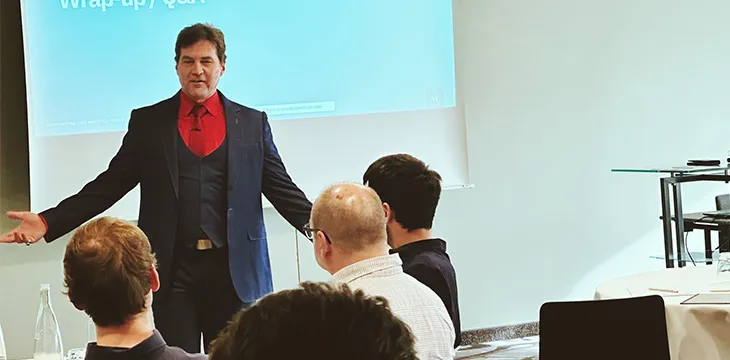|
Getting your Trinity Audio player ready...
|
“What we want is one source of truth”—and don’t be afraid to use terms like “central repository” in the blockchain world. Sometimes this is necessary for data control and security. To find out what this means, watch Session 3 of the third series of Dr. Craig Wright’s The Bitcoin Masterclasses series, held recently in Zurich.
That said, you can still have multiple decentralized copies of the same original record so long as you can prove all copies are the same as the original. (After all, that’s what the blockchain is, right?). Just as you can send Bitcoin from anywhere to anywhere, blockchain also makes it possible to attest the validity of records from anywhere to anyone. That’s a great efficiency gain.
In this session and on the other sessions in this series, as well as previous Bitcoin Masterclass series, you’ll be getting some valuable real-life education, with many examples from real life, from Dr. Wright himself.
One interesting point about this latest The Bitcoin Masterclasses is it’s less about Bitcoin technology per se and more about the processes that ensure the data processed onto the blockchain is as accurate as possible. In these cases, Bitcoin is just the “plumbing” that makes it all work. And just like regular plumbing, it can be used properly…or not.
Learning from Craig Wright’s life
Dr. Wright tends to teach lessons as a series of anecdotes from his past work experience or daily life. Though his employment history is varied, the stories ultimately revolve around finding new efficiencies, checking records with a fine-tooth comb, or identifying “outlier” records that eventually lead to wrongdoing. There are definitely a lot of “hmm, I’d never thought of that before” moments.
This session begins with one such anecdote about the traffic in Mumbai—which, combined with excessive paper-based bureaucracy, caused massive delays in shipping physical goods. Attestation from anywhere means a process that once took whole hours could be finished in seconds.
Another story comes from the New South Wales police force, where any officer was once able to access all database records. As expected, this power was occasionally abused. But keeping a log of access records allowed auditors (like Dr. Wright) to notice when something was abnormal. As he has said a few times in this series, investigators tend to notice outliers and anomalies in regular routines first.
Back to designing new processes, though, as we mentioned, the situations described here are more at the periphery of blockchain or processes that complement blockchain by integrating with it. The blockchain allows more granular data (think stocktaking, but where every single item has a unique identifier that records its entire history, rather than a number signifying a box of items or a type of item).
The idea is to take all this data and “map” it across multiple transactions. This is something that can be done with tokens. Tokens can be shared and swapped, grant or revoke access permissions, and allow access to some data but not others. This way, the single source of truth can exist without making everything viewable by anyone.
“The same way people move Boring Apes, we just want to move data,” Dr. Wright stated.
As mentioned before, you also need external processes that guarantee any human link in the chain is behaving correctly by keeping the data records accurate. Dr. Wright notes that rewards and incentives are just as good for this as rules and regulations—another thought that may have gone into Bitcoin’s original design.
Watch: Why BSV blockchain is ‘absolutely perfect’ for Bitcoin startups

 06-30-2025
06-30-2025 





